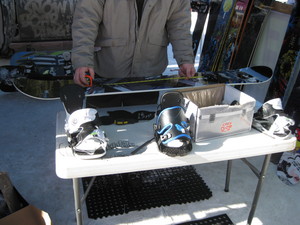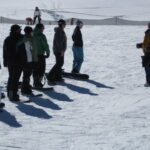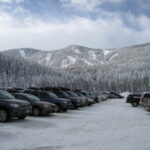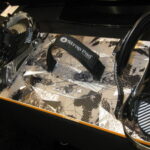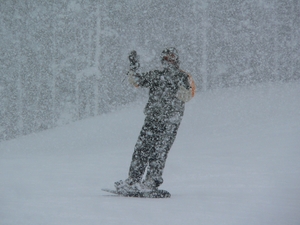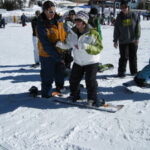One of the great things about today’s snowboards is that they are ready to be mounted with snowboard bindings straight out of the wrapper. Unlike skis, there is no need for drilling, inserts, or technical expertise. With a few simple tools and the binding manufacturers directions, snowboarders can mount their bindings in less than an hour. These are the techniques I use when mounting my own snowboard bindings.
Determine the mounting system
Most snowboard equipment manufacturers today use a fairly standardized mounting system. Snowboards use either a 3-hole pattern or a 4-hole screw pattern disc binding attachment system. Make sure the bindings you purchased have disc binding adapters for both hole patterns.
Recently, Burton Snowboards developed the EST snowboard bindings that mate with their new Channel snowboard mounting technology. These bindings require specific mounting instructions that are beyond the scope of these instructions. Consult the Burton website and the EST binding directions for mounting these bindings.
Know your riding stance
Before the bindings can be mounted, determine the snowboarders riding stance. This will determine the placement of the left and right foot binding. Those who ride with the left foot forward have a regular stance. Those who ride goofy will lead with their right foot. Take the lead foot binding and set it at the nose of the snowboard. Set the rear foot binding at the snowboard tail. The binding ratchets should be facing towards either the tip or tail of the snowboard.
Snowboard binding placement
Snowboards can be directional or twin tip boards. On directional boards, the binding inserts will have more of an offset from the tip and will be set closer to the tail of the board. On true twin tip boards, the binding inserts will be placed an equal distance from the tip and tail of the board. This will make regular and switch riding easier in the terrain park. Find the binding inserts on the snowboard. Their location will tell you what kind of snowboard you have.
Determine stance width
The distance between the two snowboard bindings is the stance width. This is generally around shoulder width apart. Most snowboard bindings come with stance width guidelines. Those are a great place to start. In reality, stance width is a very personal preference and may change with time. Terrain park riders may prefer a wider stance width while freeriders may have a slightly narrower stance. Experiment with different stance widths to find your ideal distance.
Binding angles
By now, you’ve placed the bindings on the snowboard with the correct stance and lined the bindings over the inserts that will give the desired stance width. Put the required number of screws into the binding holes and very lightly tighten them. You’ll then need to set the binding angles. Binding angles are also determined by riding style and personal preferences. A good place to start is the front binding at 15 degrees and the rear binding at -5 degrees.
Center the bindings
Before completely tightening the binding base screws, make sure the bindings are centered over the snowboard. This will keep the snowboarders stance centered on the board.
Place snowboard boots in the bindings and check to make sure the toes and heels of the boots to not hang over the edges. Excessive overhang may require the use of binding risers or the purchase of a wide version of the snowboard model. If everything is okay, tighten the base disc screws. Do not use locktite on the binding screws.
Adjust the binding straps
Place snowboard boots in the bindings and check the fit. The ankle strap pads should be centered over the boot. The toe strap pad or toe caps should be centered over the toes. The ankle and toe straps should be able to easily ratchet closed.
Adjust the highbacks
The binding highbacks will be to be adjusted so that they are parallel to the heelside edge. Consult the binding directions on how to make this adjustment. The forward lean on the highbacks can also be adjusted. Freestylers use little forward lean while freeriders usually use more.
Your snowboard bindings are now mounted and ready for riding. As you use them, you may need to adjust them as the straps stretch and you change your preferences.
More on snowboarding equipment:
How to Buy Snowboard Goggles
How to Buy a Snowboard
Tips for Choosing Snowboard Boots
Sources:
personal knowledge and experience
